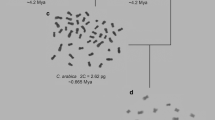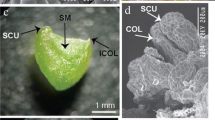Abstract
Age of explant and six different media were evaluated with the objective of regenerating higher numbers of interspecific hybrids between sexual and apomictic Brachiaria. Immature embryos of 7–8, 9–10 and 11–12 days after pollination (DAP), from artificial hybridization between Brachiaria ruziziensis (R) as female parent, and B. brizantha (B) or B. decumbens (D) as male parent, were cultured in modified MS media (M4) – supplemented with different combinations of growth regulators and vitamins. Embryos cultured 9–12 DAP showed high percentage (85–100%) of germination for all the crosses examined. Germination and survival rates varied according to accessions within crosses. Six different media (all modified MS with different growth regulators and vitamins) were tested with the objective of inducing multiple shoots from 7 to 10 DAP embryos, from crosses between R × B. The media M1, supplemented with Kinetin (13.94 μM) and NAA (5.37 μM), and media M3, supplemented with BA (4.44 μM and IAA 2.85 μM), regenerated adventitious shoots and calli about 30–40 days after inoculation. The highest multiplication rate observed was 2.85 shoots per explant in media M1, 60–70 days after culturing. Two other media, M6, supplemented with 2,4-D (13.57 μM) and M2, with 2,4-D (9.05 μM) and BA (8.87 μM) exclusively induced the formation of calli. The described protocols proved to be efficient in regenerating healthy seedlings from immature embryos of interspecific hybrids in Brachiaria.
Similar content being viewed by others
References
Bai D & Knott DR (1992) The effects of level of 2,4-D and time in culture on regeneration rate and chromosome numbers of regenerantes from calli of the hybrid Triticum aestivum cv. Chinese Spring ph1b x Thinopyrum ponticum (2n=10x=70). Genome, 36: 166–172
Browe P, Douglas J, Grace JP & Marshall DR (1982) Interspecific hybridization of soybean and perennial Glycine species indigenous to Australia via embryo culture. Euphytica 31: 715–724
Dornnelles ALC, Carvalho FIF, Federizzi LC, Lange CE, Handel CL & Bered F (1997) Genetics of regeneration of wheat (Triticum aestivum L.) plants. Braz. J. Genet. 20: 293–297
Gill BS, Waines JG & Sharma HC (1981) Endosperm abortion and the production of viable Aegilops squarrosa x Triticum boroticum hybrids by embryo culture. Plant Sci. Lett. 23: 181–187
Gobbe J, Longly B & Louant BP (1983) Apomixie, sexualité et amélioration des graminées tropicales. Tropicultura 1: 5–9
Hang A & Bregitzer P (1993) Chromosomal variations in immature embryo-derived calli from six barley cultivars. J. Hered. 84: 105–108
Hu CY & Ferreira AG (1990) Cultura de Embriões. In: Torres AC & Caldas LS (eds). Técnicas e Aplicações da Cultura de Tecidos de Plantas (pp 71–85). Brasília, ABCTP/EMBRAPA-CNPH
Hungtu M, Minghong G & Liang GH (1987) Plant regeneration from cultures immature embryos of Sorghum bicolor (L.) Moench. Theor. Appl. Genet. 73: 389–394
Kanoh K, Hayashi M, Serizawa Y & Konishi T(1988) Production of interspecific hybrids between Lilium longiflorum and L. elegance by ovary slice culture. Japan J. Breed. 38: 278–282
Lenis Manzano SJ (1992) Regeneración de plantas de la graminea forrajera tropical Brachiaria spp. a partir de tejidos cultivados in vitro (Monography. 87 p). Univ. Santiago de Cali, Cali
Linsmaier EM & Skoog F (1965) Organic growth factor requirement of tobacco tissue cultures. Physiol. Plant. 18: 100–127
Lutts S, Ndikumana J & Louant BP (1991) Fertility of Brachiaria ruziziensis in interspecific crosses with Brachiaria decumbens and Brachiaria brizantha: meiotic behavior, pollen viability and seed set. Euphytica 57: 267–274
Maddock SE, Lancaster VA, Risiott R & Franklin J (1983) Plant regeneration from cultured immature embryos and inflorescence of 25 cultivars of wheat (Triticum aestivum). J. Exp. Bot. 34: 915–926
McDonnell RE & Conger BV (1984) Callus induction and plantlet formation from mature embryo explants of Kentucky Bluegrass. Crop Sci. 24: 573–578
Miles JW & do Valle CB (1996) Manipulation of apomixis in Brachiaria breeding. In: Miles JW, Maass BL & do Valle CB (eds) Brachiaria: Biology, Agronomy, and Improvement (pp. 164–177). CIAT/EMBRAPA-CNPGC, Cali, Colombia
Murashige T & Skoog F (1962) A revised medium for rapid growth and bio assays with tobacco tissue culture. Physiol. Plant. 15: 473–497
Ndikumana J (1985) Etude de l'hybridation entre espèces apomictiques et sexuées dans le genre Brachiaria. (PhD dissertation, 210 pp.). Université Catholique de Louvain. Louvain-La-Neuve, Belgium
Nomura Y & Osawa K (1990) Production of interspecific hybrids between Allium chinense and A. thunbergii by in ovule embryo culture. Japan J. Breed. 40: 531–535
Ozias-Akins P & Vasil IK (1982) Plant regeneration from cultures immature embryos and inflorescences of Triticum aestivum L. (wheat): evidence for somatic embryogenesis. Protoplasma 110: 95–105
Raghavam V (1966) Nutrition growth and morphogenesis of plant embryo. Biol. Ver. 41: 1–58
Renvoize SA, Clayton WD & Kabuye CHS (1996) Morphology, taxonomy and natural distribution of Brachiaria (Trin.) Griseb. In: Miles JW, Maass BL & do Valle CB (eds) Brachiaria: Biology, Agronomy, and Improvement (pp. 1–15). CIAT/EMBRAPA-CNPGC, Cali, Colombia
Rodrigues BM, Pinto JEPB, Maluf WR & Souza CM (1997) Propagação in vitro de cebola (Allium cepa L.) a partir de tecidos de bulbos. Ci. Agrotecnol. 21: 343–352
Shimada T & Yamada Y (1979) Wheat plants regenerated from embryo cell culture. J. J. Genet. 54: 379–385
Swenne A, Louant BP & Dujardin M (1981) Induction par la colchicine de formes autotétraploides chez Brachiaria ruziziensis Germain et Evrard (Graminée). Agron. Trop. 36: 134–141
Takamizo T, Suginobu K & Ohsugi R (1990) Plant regeneration from suspension culture derived protoplasts of tall fescue (Festuca arundinacea Schreb.) of a single genotype. Plant Sci. 72: 125–131
Thome J, Palacios N, Lenis S & Roca W (1996) Applications of Biotechnology to Brachiaria In: Miles JW, Maass BL & do Valle CB (eds) Brachiaria: Biology, Agronomy, and Improvement (pp 196–204). CIAT/EMBRAPA-CNPGC, Cali, Colombia
Valle CB do, Leguizamon GOC & Guedes NR (1991) Interspecific hybrids of Brachiaria (Gramineae). Apomixis Newsl. 3: 10–11
Van Tuyl JM, van Dien MP, van Creij MGM, van Kleinwee TCM, Franken J & Bino RJ (1991) Application of in vitro pollination ovary culture, ovule culture and embryo rescue for overcoming incongruity barriers in interspecific Lilium crosses. Plant Sci. 74: 115–126
Vasil V & Vasil IK (1982) The ontogeny of somatic embryos of Pennisetum americanum (L.) K. Schum. I. in cultured immature embryos. Bot. Gaz 143: 454–465
Zimmer AH & Euclides Filho K (1997) As pastagens e a pecuária de corte brasileira. In: Simpósio Internacional sobre Produção Animal em Pastejo, 1997. Viçosa. Proceedings (pp 1–29). Viçosa, 4–6 November 1997
Author information
Authors and Affiliations
Rights and permissions
About this article
Cite this article
Rodrigues-Otubo, B., de O. Penteado, M. & do Valle, C. Embryo rescue of interspecific hybrids of Brachiaria spp. Plant Cell, Tissue and Organ Culture 61, 175–182 (2000). https://doi.org/10.1023/A:1006478407814
Issue Date:
DOI: https://doi.org/10.1023/A:1006478407814




